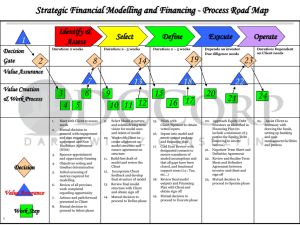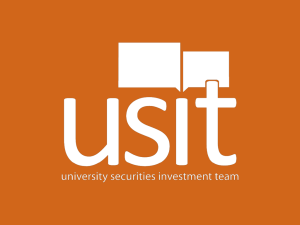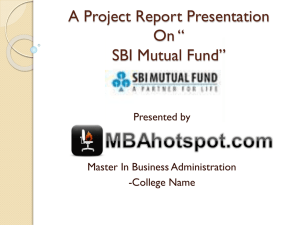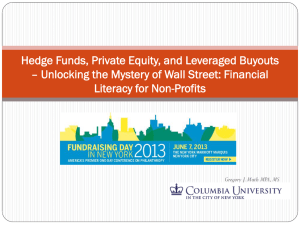AMFI Certification Program for Mutual Fund Intermediaries
advertisement
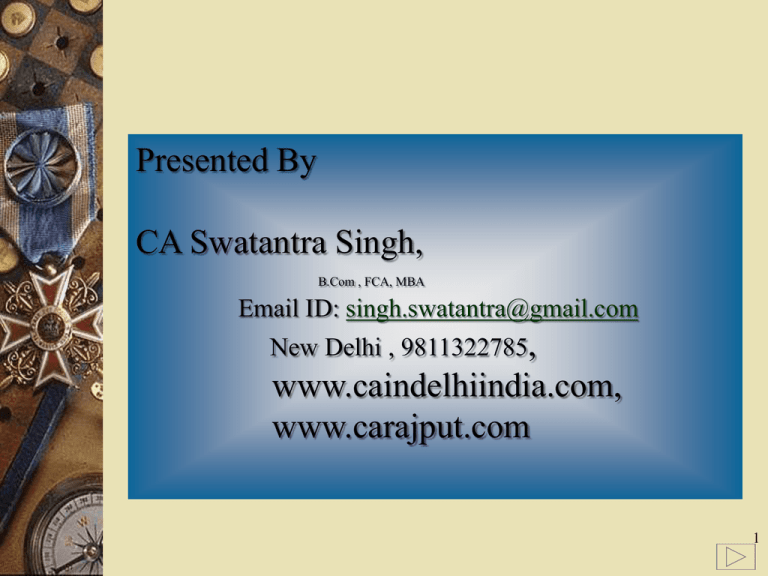
Presented By CA Swatantra Singh, B.Com , FCA, MBA Email ID: singh.swatantra@gmail.com New Delhi , 9811322785, www.caindelhiindia.com, www.carajput.com 1 “Behavioral Trends in Mutual Funds” Mutual Fund An Investor’s Best Friend In the World of Risk” A wise man should have money in his head, not in his hand. -Jonathan Swift (1667-1745) Mutual Fund Vehicle for collective investments to pool their marginal resources & invest in Securities & distribute the returns. Advantages of Mutual Funds – – – – – – – Portfolio diversification Professional management Reduction / diversification of risk Reduction of transaction cost Liquidity Convenience and flexibility Tax Benefits Disadvantages of Mutual Funds – No control over costs – No tailor-made portfolio – Managing a portfolio of funds Fund distribution and sales practices Who can invest Who can invest in mutual funds – – – – – – – – – Resident individuals Indian companies Indian trusts / Charitable institutions Banks Non-banking finance companies Insurance companies Provident funds Non-resident Indians (Repatriable and non- repatriable) Foreign Institutional Investors Distribution Channels Types of distribution channels – All distributors and employees of distribution companies to be AMFI certified – Individual agents – Distribution Companies – Banks and non-banking finance companies • Largest mobilizers form mutual funds – Direct marketing by mutual funds Agent commissions.. – Agents are paid commission for distribution of mutual funds • 1.50pct to 3.00pct for equity funds • 0.40pct to 1.25pct for debt funds – Maximum agency commission restricted to 6pct initial issue expenses – Agency commission may be paid out of entry / exit load subject to overall expense limits Services by Agents.. – Understand all aspects of the schemes – Understand client profile in terms of • Age profile • Risk appetite • Income and liquidity requirements – Offer clients investments suitable to investors profile – Continuous monitoring of client’s investments – Personalised after sales service Investor services by Mutual Funds.. – Phone transactions - Interactive voice recognition system – Cheque writing facility – Sweep facility to bank accounts – Periodic statements and tax information – Loan against units – Nomination facility – Transfer of units through listing of close ended funds Measuring mutual fund performance.. One of the Method End NAV - Start NAV Start NAV 12or365 100 No. of months or days – This method gives the annualised returns in percentage – If annualised returns are not required, the month / day calculation is deleted. You then get absolute returns in percentage – If annualised, suitable for investments only in growth option of all types of funds as dividend is not considered Useful tips for making Investments in mutual Funds – Consider the effect of loads – Compare similar time periods – For less than one year period calculate returns on absolute basis except for money market funds – For a period of one year and more calculate returns on annualised basis – Watch the total Returns since inception When should one invest through a Mutual Fund ? have a small amount to invest hold fewer than five stock one need better advice on investing have difficulty in deciding when to sell find the paper work relating to investments cumbersome Types of mutual fund On the basis of objective On the basis of structure On the basis of payout Open ended Dividend Close ended Equity Index Dividend payout Debt Diversified Balanced Growth Dividend Re-invest Liquid Sectoral Gilt Constitution of Mutual Fund Fund Sponsor (Promoter of the Fund) Fund Sponsor (Promoter of the Fund) Fund Sponsor (Promoter of the Fund) Custodian Transfer Agents Distributors Brokers INVESTMENT IN MUTUAL FUND IDEAL INSTRUMENT TO INVEST FOR THOSE WHO DON’T HAVE TIME TO DO THE RESEARCH FOR INVESTMENT IN EQUITY ALSO FOR THOSE WHO DOES NOT HAVE LARGE SUM TO INVEST IN EQUITY SHARES OF LARGE CAP OR MIDCAP PROMINENT COMPANIES & WANTS TO PARTICIPATE IN GROWTH STORIES OF THESE KIND OF COMPANIES. 18 INVESTMENT IN MUTUAL FUND TODAY MUTUAL FUNDS ASSETS UNDER MANAGEMENT IS ALMOST 781000 CRORE. INVEST IN STOCK MARKET AFTER EXTENSIVE RESEARCH. PROFESSIONAL MANAGEMENT DIVERSIFICATION EXCELLENT RETURN POTENTIAL IN LONG RUN LIQUIDITY 19 Investment Management Equity portfolio management.. Fund management organisation structure – Fund manager Performs asset allocation – Security analyst Supports the fund managers through analytical reports (Fundamental, technical and quantitative) – Security dealers Executes actual buying and selling through brokers Equity portfolio management.. Equity Research – Fundamental analysis The study of the Financial health of a particular company, by studying the past 3 to 5 years Balance sheets & Profit & Loss accounts – Technical analysis The study of the market movements of share price of a company or industry / sector to predict the future trend – Quantitative analysis The use of mathematical models for equity valuation Equity portfolio management.. Types of equity instruments – Ordinary shares – Preference shares – Equity warrants – Convertible debentures Derivatives – Futures – Options Equity portfolio management.. Portfolio management process – Set Investment policy – Perform security analysis and research – Construct a portfolio – Revise the portfolio – Evaluate the performance of the portfolio Debt portfolio management.. Fund management organisation structure – Fund manager Performs asset allocation – Security dealers Executes actual buying and selling through brokers – Interest rate forecasting unit Economists who do research on interest rates – Risk Managers Oversee risk levels attained by fund managers Debt portfolio management.. Types of debt instruments – Certificate of deposit – Commercial paper – Corporate debentures – Floating rate bonds – Government securities – Treasury bills – Bank / Financial Institution bonds – Public sector undertaking bonds Debt portfolio management.. Risks in investing in bonds – Interest rate risk • Price of bonds are inversely proportional to interest rates – Reinvestment risk • Coupon received may not get invested at the coupon rate itself – Call risk • If bond provides a call option, the bond may get called if interest rates drop. Reinvestment will then happen at lower rates Debt portfolio management.. Risks of investing in bonds – Default risk • Credit risk of default on repayment of interest / principal by the issuer – Inflation risk • Rise in inflation results in lower purchasing power on coupon received, making the bond lose value – Liquidity risk • Illiquidity leads to incorrect pricing and desperate sales Debt portfolio management.. Risks of investing in bonds – Default risk • Credit risk of default on repayment of interest / principal by the issuer – Inflation risk • Rise in inflation results in lower purchasing power on coupon received, making the bond lose value – Liquidity risk • Illiquidity leads to incorrect pricing and desperate sales WEALTH CREATION - EQUITY INVESTMENT ROUTE 30 STOCK MARKET FROM THE LOW OF 8000 LAST YEAR NOW CLIMBING HIGHER - CELEBRATION ALL AROUND SENSEX AT 17000 31 SENSEX AT 17000 NIFTY AT 5089 BUT IS IT TRUE THAT EVERYBODY MADE MONEY? ONLY HANDFUL PEOPLE CREATED WEALTH, SOME MADE LITTLE BIT OF MONEY BUT MOST OF COMMON PEOPLE HAVE LOST MONEY. WHY? BECAUSE MAJORITY OF PEOPLE ARE NOT INVESTORS BUT ARE PUNTERS, DAY TRADERS. 32 ALL EYES ON INDIA - INTERESTING INDIA GROWTH STORY STILL LONG LONG WAY TO GO - JOIN THE BAND WAGON 33 INDIA GROWTH STORY INDIA IS DOMESTIC CONSUMPTION STORY CHANGING DEMOGRAPHIC PATTERN WITH HIGH PERCENTAGE OF YOUTH EARNING IN THE COUNTRY WITH HIGHER DISPOSABLE INCOME CREATED CONSUMPTION BOOM. 34 INDIA GROWTH STORY IT ALL STARTED WITH LOWER INTEREST RATE LOW INTEREST RATE HELPED HIGH DEMAND FOR HOUSING, CAR, TWO WHEELER. IN TURN ALL THESE BOOSTED THE DEMAND FOR CEMENT, STEEL, AUTO ANCILIARIES, INFRASTRUCTURE, BANKING & FINANCE FACILITIES, TECHNOLOGY ETC. 35 WHY INVESTMENT BECAUSE MONEY DOES N’T GROW ON TREE, SO TILL IT HAPPENS WE HAVE TO PARK OUR SAVINGS SMARTLY TO GET GOOD RETURN ABOVE BANK INTEREST. 36 WHY INVESTMENT TO FULFILL OUR DREAMS LIKE: WELL FURNISHED APARTMENT CAR, WORLD TOUR, FARM HOUSE, CHILDREN’S EDUCATION ETC. IS IT POSSIBLE WITH YOUR ROUTINE BUSINESS INCOME OR FROM SALARY? 37 WHY INVESTMENT NO SOCIAL SECURITY IN INDIA, SO FOR THE FUTURE, FOR THE RETIREMENT, FOR THE RAINY DAY ONE OUGHT TO HAVE ENOUGH. 38 WHY INVESTMENT ACTIVE INCOME INCOME FROM OUR BUSINESS, PROFESSION, JOB, WHAT WE DO ACTIVELY TO EARN MONEY. 39 WHY INVESTMENT PASSIVE INCOME – EARNED FROM INVESTMENT IN VARIOUS OPTIONS. I.E. DIVIDEND, INTEREST, RENT, CAPITAL APPRECIATION ON SHARES, M.FUND. 40 WHY INVESTMENT ACTIVE INCOME : - Needs constant devotion of time & action, Physical work - To earn more, more work - Requires Physical Presence PASSIVE INCOME : - Needs assets & ideas to generate income - Can be earned more by working smarter & not harder - Requires more of mental presence 41 WHY INVESTMENT - Suffers high rate of taxation - There is limited ( business & profession ) or no resale value ( Job ) - Has limited or no leverage potential to earn active income - Attracts lower or no taxation - Normally asset has resale value - Assets and Income can be leveraged to earn passive income. 42 WHY INVESTMENT Those who focus only on earning active income get left behind to those who concentrate on complementing their active income with passive income. So, to retire rich and early one must have more passive income which could take care of your expenses in later part of your life. 43 INVESTMENT DECISION - MAKING CHOOSING THE MOST PROFITABLE & SUITABLE ALTERNATIVE FROM PLENTY OF OPTIONS. PORTFOLIO HAS TO BE DESIGNED AS PER OBJECTIVE OF INVESTOR, HIS AGE, HIS INCOME, TIME HORIZON, RISK & RETURN PROFILE, FAMILY NEEDS, TAX STRUCTURE & GOVT. POLICIES. 44 THE TRIO OF INVESTMENT – RETURN , RISK & TAXATION Returns- What are the return on the investment - in value and percentage terms on an annualized basis? Return may be in form of Interest, Dividend, Rent and / or Capital Appreciation. 45 Risk : What are the risks involved in making the investment? Normally, higher the return, higher the risk and lower the risk then lower would be the return. The different types of risk includes, price fluctuations, liquidity, default, Inflation, interest rate and currency risk. 46 Taxation : In order to maximize one’s real return on investment after taxes, taxation needs to be considered and planned to minimize its impact. 47 INVESTMENT OPTIONS • • • • • • • • PLENTY OF OPTIONS, SUCH AS : ( a ) Fixed Income Deposits & Securities ( b ) Tax Savings Schemes ( c ) Equity Shares ( d ) Mutual Funds ( e ) Insurance ( f ) Real Estate ( g ) Precious Metals like Gold, Silver ( h ) Derivatives 48 INVESTMENT MODEL : Age Scenario 20's Acquiring vocational skills and education (degree) Strategy Assets Allocation * No dependants Equity : 70% No self-generated assets Debt 10% : Taking a job or setting up Invest the surplus income Sml. Saving : 15% Business / profession in growth assets like Insurance : 5% Shares, mutual funds, Maximize the tax savings Start buying life, medical and accident insurance 30's Marriage & starting a family * Continue to invest a major Equity : 60% Getting settled in a job, portion of income into growth Debt : 10% business or profession assets , Accumulate fund Sml.Saving :20% Spouse may or may not to buy a residence in the future, Insurance :10% be an earning member Increase insurance coverage 49 Need for larger house for entire family INVESTMENT MODEL : Age Scenario Strategy Assets Allocation 40's Planning for the future needs Acquire a house with or Equity : 40% Buying a residential house without housing loan Debt : 15% High surplus income Reduce exposure to risky Small Saving: 25% investment Insurance : 20% Increase life cover Plan for retirement and needs of the family, especially children Create a contingency fund 50s Planning for Retirement Repay housing loan, if taken Equity : 20% Children have grown up Payoff all debts Debt : 45% and are towards becoming Think of retirement needs, Small Saving: 20% independent Surplus for plan and take appropriate action Insurance : 15% investment is at peak Ensure that passive income is much higher than active income 50 INVESTMENT MODEL : Age Scenario Strategy Assets Allocation 60+ Retirement Retire from work, not life Assets generate regular Equity : 15% Continue work only if cash flow for maintenance Debt : 50% you want to or work and expenses Sml.Saving: 25% part-time Ensure that the earning Insurance : 10% Children are independent from passive income and earning on their own are higher than the rate of inflation No need for life insurance, but ensure that maximum medical insurance is obtained for oneself and spouse 51 INVESTMENT IN EQUITY SHARES COMPELLING REASON TO INVEST IN EQUITY SHARES : BSE Sensex 1978 – 79 = 100 & 2009 – 10 = 17000 52 INVESTMENT IN EQUITY SHARES When inflation is almost 8 to 9%, our savings should generate higher return than that. At present interest on Bank Deposit, PPF is around 7 to 8%, So, no incentive for general investor to park money there. Previous slide shows Indian Stock Market has given most handsome return, Equity gave compounded annual return of almost 18% So, make share investment your sleeping partner. Let us see some example of wealth creationCopy of WEALTH CREATION FACTS & FIGURES.xls 53 FUNDAMENTAL PRINCIPLES OF INVESTMENT IN EQUITY “Research before you invest and not after” Always invest for long term, Wealth can be created only in long term, in short term some quick buck can be made by chance only. Warren Buffet says “ only buy something that you would be perfectly happy to hold if market shut down for 10 years. Don’t buy on some one’s tip. So, don’t indulge in speculation, it could burn your fingers. 54 FUNDAMENTAL PRINCIPLES OF INVESTMENT IN EQUITY Good Investment Decisions depends on how you invest, I.e. - Which stock you invest in - When you buy the stock - When you sell the stock So, trick to create wealth in stock market is buying the right stock at the right time and selling the same at right time. 55 RESEARCH PROCESS ANALYSE THE OVERALL PICTURE OF VARIOUS SECTORS OF ECONOMY I.e : CEMENT - STEEL - AUTOMOBILES CONSTRUCTION, REAL ESTATE & INFRASTRUCTURE - ENGG. & CAPITAL GOODS - MEDIA & ENTERTAINMENT TELECOM - TECHNOLOGY - TEXTILE RETAIL - FINANCIAL - FMCG - PHARMA CONSUMER DURABLES - OIL & GAS ETC. 56 RESEARCH PROCESS ALSO CONSIDER CERTAIN MACRO & MICRO ECONOMY FACTORS SUCH AS INTEREST RATE, INFLATION, FOREIGN FUND INFLOW & OUT FLOW & IT’S IMPACT ON CURRENCY STRENGTH ETC. EVALUATE OVERALL VALUATION OF MARKET, IT’S PE RATIO & COMPARE THE SAME WITH HISTORICAL VALUATION 57 RESEARCH PROCESS • IDENTIFY STRONG BUSINESSES / INDUSTRIES WHICH HAS SUPERIOR RETURN PROSPECTS, GOOD BUSINESS MODEL, PREDICTABLE CASH FLOWS AND SUSTAINABLE LONG TERM COMPETITIVE ADVANTAGES 58 RESEARCH PROCESS FIND THE VALUE IN EARLY STAGE, WHEN PRICE DISCOVERY IS NOT FULL AS IT IS RELATIVELY LESS KNOWN BY OTHER MARKET PARTICIPANTS, SO SHARE WOULD BE AVAILABLE AT CHEAP PRICE / VALUATION COMPANIES IN ITS GESTATION PERIOD BUILDING ITS INFRASTRUCTURE, MARKETING NETWORK, RESEARCH ETC. 59 RESEARCH PROCESS STUDY THE FINANCIALS BALANCE SHEET, P & L A/C., CASH FLOW STATEMENT. ANALYSE VARIOUS COMPONENT OF B’SHEET LIKE CAPITAL STRUCTURE, RESERVES, LIABILITIES COMPARE ITS QTLY. RESULTS & SEE THE SEQUENTIAL GROWTH IN SALES, PROFIT, CASH FLOW, STUDY VARIOUS RATIOS LIKE, EPS, P/E RATIO, DEBT / EQUITY RATIO,CURRENT RATIO, PRICE / BOOK VALUE & DIVIDEND YIELD ETC. 60 RESEARCH PROCESS BUSINESS LIFE CYCLE MATURITY DECLINE GROWTH INCEPTION 1 2 3 TIME - YEARS 61 4 5 BUYING SHARES AFTER WEIGHING ALL THE OPTIONS PURCHASE THE SHARES OF SELECTED COMPANIES REMEMBER TO DIVERSIFY YOUR PORTFOLIO TO DIFFERENT SECTORS WHICH ARE DOING WELL 62 TRACK YOUR PORTFOLIO AFTER BUYING THE SHARES OF GOOD COMPANIES, KEEP PATIENCE, GIVE IT TIME TO GROW DON’T EXPECT IMMEDIATE GAIN CONSTANTLY MONITOR COMPANY’S PERFORMANCE - TRACK ITS QUARTERLY RESULTS & ANALYSE THE SAME. IF FOUND SATISFACTORY ONE MAY ADD EXPOSURE BY BUYING MORE SHARES. 63 TRACK YOUR PORTFOLIO ALSO KEEP TRACK OF OVERALL MARKET CONDITION, SENTIMENTS, INFLATION, INTEREST RATE, SOME EVENTS LIKE FINANCE BILL & IT’S IMPACT ON MARKET IN GENERAL OR ON SOME SPECIFIC SECTORS. KEEP CLOSE WATCH ON GEO – POLITICAL ENVIRONMENT 64 BOOKING PROFIT WHEN ONE HAS TO TAKE DECISION TO SELL ? ALWAYS REVISIT YOUR INVESTMENT PERSPECTIVE / OBJECTIVE, EXPECTED RETURN, TIME HORIZON, NEED OF MONEY AND SO ON & WHEN ONE FEELS THAT MY INVESTMENT OBJECTIVES HAVE BEEN FULFILLED, ONE SHOULD SELL & BOOK PROFIT FROM THE INVESTMENT. 65 Presented By 66 CA Swatantra Singh, B.Com , FCA, MBA Email ID: singh.swatantra@gmail.com New Delhi , 9811322785, www.caindelhiindia.com, www.carajput.com 67


